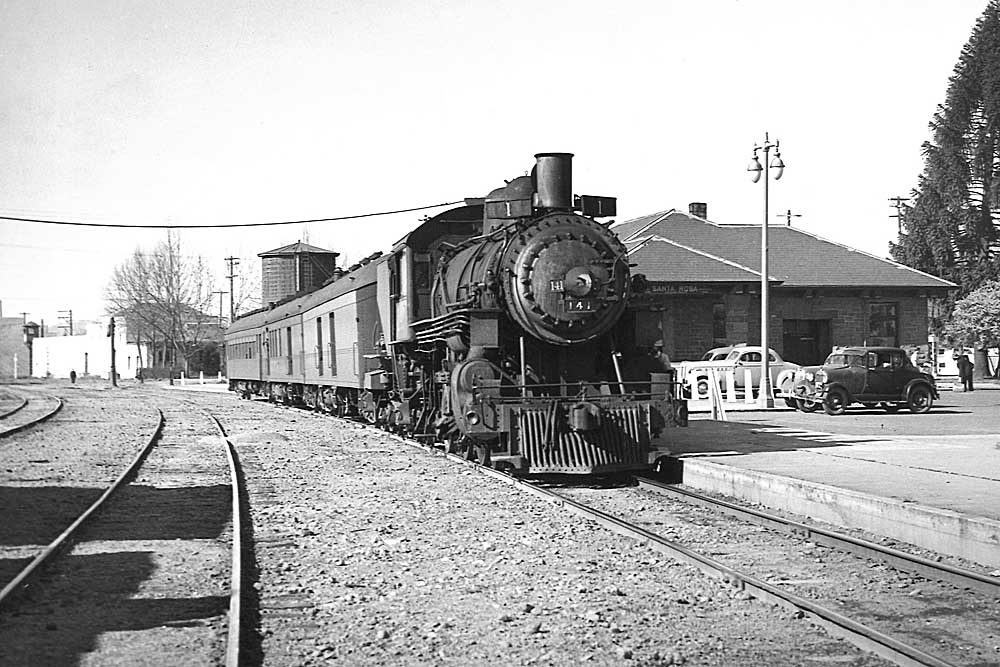
More than a few times, photographs in the Kalmbach library have sent me searching for railroads and places I’ve never encountered, and a few weeks ago some 8 x 10 prints lined up perfectly with travel plans. The destination: Mendocino, Calif., the charming old lumber town up the coast 155 miles from San Francisco.
My itinerary got me thinking, “What’s left of the old Northwestern Pacific?” I’ve long been curious about this fabled Northern California railroad but I’ve known next to nothing about it. After flying out there from Milwaukee, my drive north from SFO along U.S. 101, the Pacific Highway, would have me tracing the old NWP’s route for a couple of hours.
A short visit to the company’s photo files sealed the deal. The first picture I encountered, shown here, was made in the late 1940s by my old friend the late Art Lloyd, railroad historian, preservationist, and longtime Western Pacific p.r. man. It’s really a classic railroad image of the three-quarter vein: a stout NWP 4-6-0 leads the short consist of train No. 1 into the sun from the handsome station at Santa Rosa, milepost 55 from Sausalito in the old NWP timetable.
My road trip would take me right through Santa Rosa, so I had to stop.
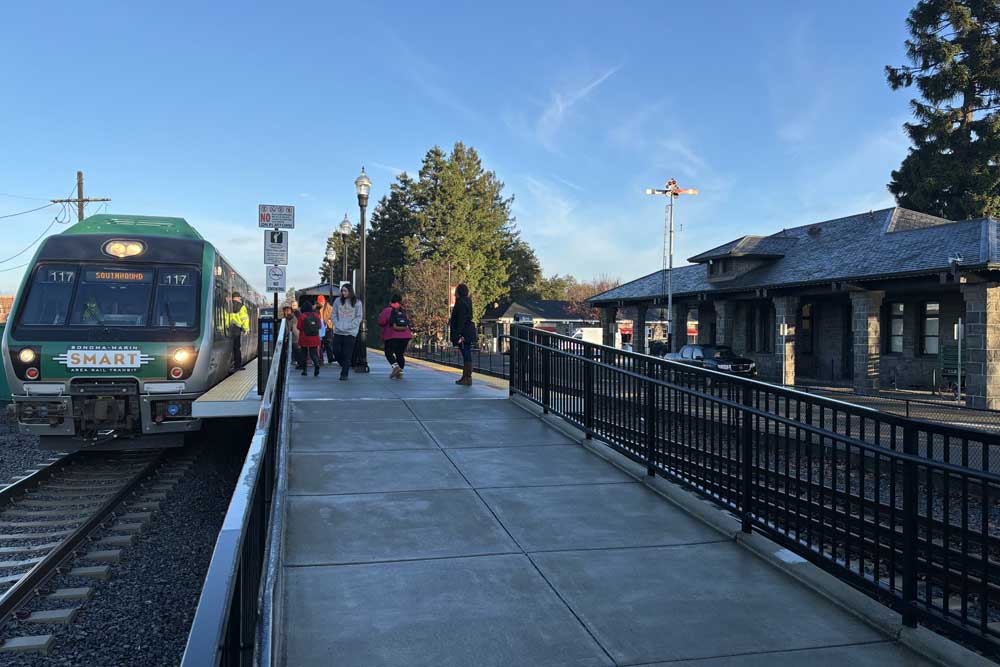
As loyal fans of the railroad all know, this stretch of the former NWP today is very much alive as the province of Sonoma-Marin Area Rail Transit, or SMART, a new (2019) operation running 19 daily trains each way over a 43-mile stretch from the northern edge of Santa Rosa down to Larkspur, where the rail line connects with the Larkspur Ferry Terminal and its various services across the Bay.
The commuter agency owns a lot more track, including a planned extension north from Santa Rosa through Healdsburg to Cloverdale. In fact, the original track up that way is mostly in place, something I witnessed from following on U.S. 101, all of it “railbanked” for that day when SMART has the resources and sufficient support to push northward.
As luck would have it, I arrived at the Santa Rosa depot just as one of the morning trains was pulling in. I wasn’t prepared for its equipment: one of the railroad’s nine Nippon-Sharyo two-unit DMU trainsets, shiny in stainless steel and green. Utilitarian rather than handsome, they struck me as updates on the classic RDC, with their underslung and noticeably quiet Cummins 760-h.p. diesel-hydraulic power plants.
Alas, the train wasn’t really arriving at the original 1903 NWP station. SMART trains use an adjacent station with a small shelter and high-level platforms. But the stout old stone depot — perhaps you’ve seen it in Alfred Hitchcock’s 1943 film “Shadow of a Doubt” — has been nicely preserved and serves as the headquarters for Santa Rosa’s visitors bureau. The realignment of the SMART main line makes it difficult to get both a DMU train and the old station in the same image, but I gave it a go.
A couple other pictures shown here add a bit more to the NWP mystique. One, by the prodigious Western photographer Fred Matthews, shows one of those handsome SP-style, Vanderbilt-tank-equipped Ten Wheelers bringing train 3 over the Russian River bridge after departing Healdsburg in October 1950. The NWP had numerous tunnels, plus dozens of bridges crossing the various rivers and streams coming down off the Coast Range. The NWP had a rugged profile, too. In the shot here by Jack Farley, another 4-6-0 on train 1 climbs the grade out of San Rafael just minutes ahead of arrival at the ferry dock in March 1946.
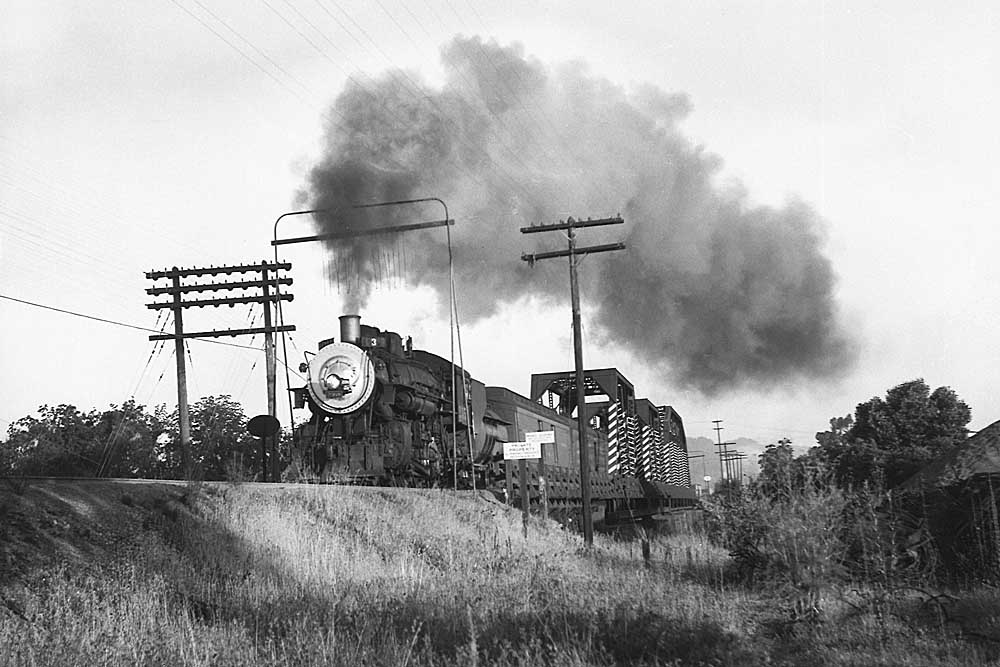
The history of the Northwestern Pacific is way too convoluted to convey here in any detail, but it’s an amazing story. What started as the Petaluma & Haystack Railroad (how prosaic is that?) over the decades became a sprawling, wholly improbable amalgamation of 41 companies. It officially became the Northwestern Pacific in 1906, co-owned by Southern Pacific and Santa Fe based on their tangled ownership of predecessor lines. Its main line ultimately stretched 271 miles from Sausalito to Eureka. The SP finally took over the whole shebang in 1929.
How improbable was NWP’s evolution? Here’s how authors Fred Codoni and Paul C. Trimble described the line in their book “Northwestern Pacific Railroad,” published in 2006 by the Northwestern Pacific Historical Society:
“Consider: standard gauge, narrow-gauge, steam, diesel-electric, gas-electric, and straight-electric trains carrying passengers, freight, mail, and express and connecting with ferryboats for passenger, railcars, automobiles, and a tugboat. It pioneered electric railroad technology, developed the first cab-forward locomotive, and rank on tracks with two, three, and even four rails. The system was an effective feeder and subsidiary of the largest railroad in the West, yet at the same time had a subsidiary railroad of its own operating interurban passenger and freight services, stern-wheel riverboats, and tug and barge services.”
My encounter with the remnants of the Northwestern Pacific was brief but captivating, and I’m not finished digging into its history. Fortunately, there are more good books about the NWP, notably the standard reference “Northwestern Pacific Railroad: Redwood Empire Route,” published in 1964 by authors Fred Stindt and Guy L. Dunscomb, both eminent California rail historians.
Then there’s “Redwood Railways: A History of the Northwestern Pacific Railroad and Predecessor Lines,” published in 1956 by Howell-North by Gilbert H. Kneiss, longtime VP of public relations for Western Pacific. Kneiss was well connected enough to recruit none other than Lucius Beebe for a Foreword. Beebe inimitably described the NWP as “removed at its farthest possible extreme from cities and the ways of cities, their rights of way grassgrown to the point of actual impediment of progress, their locomotives of the genus teakettle.”
Standing on the platform at Santa Rosa, not far from where photographer Art Lloyd stood, I watched those slick new DMUs roll into town and thought there’s nothing “teakettle” about the SMART operation. Is it as appealing as the old NWP? Nope. But can we rejoice in its partial revival? Of course! I’m looking forward to going back.
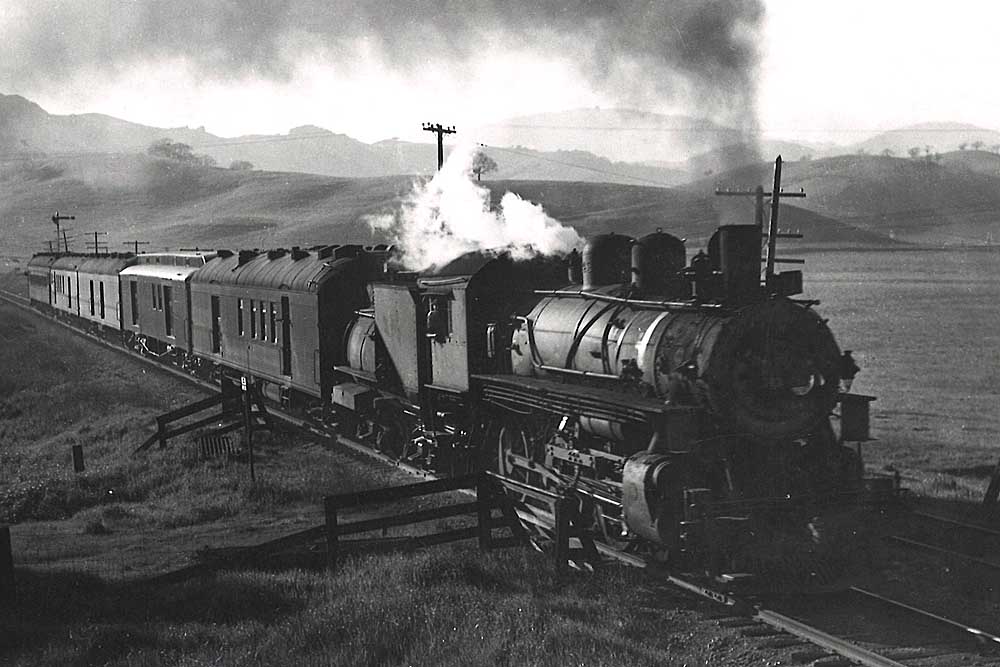









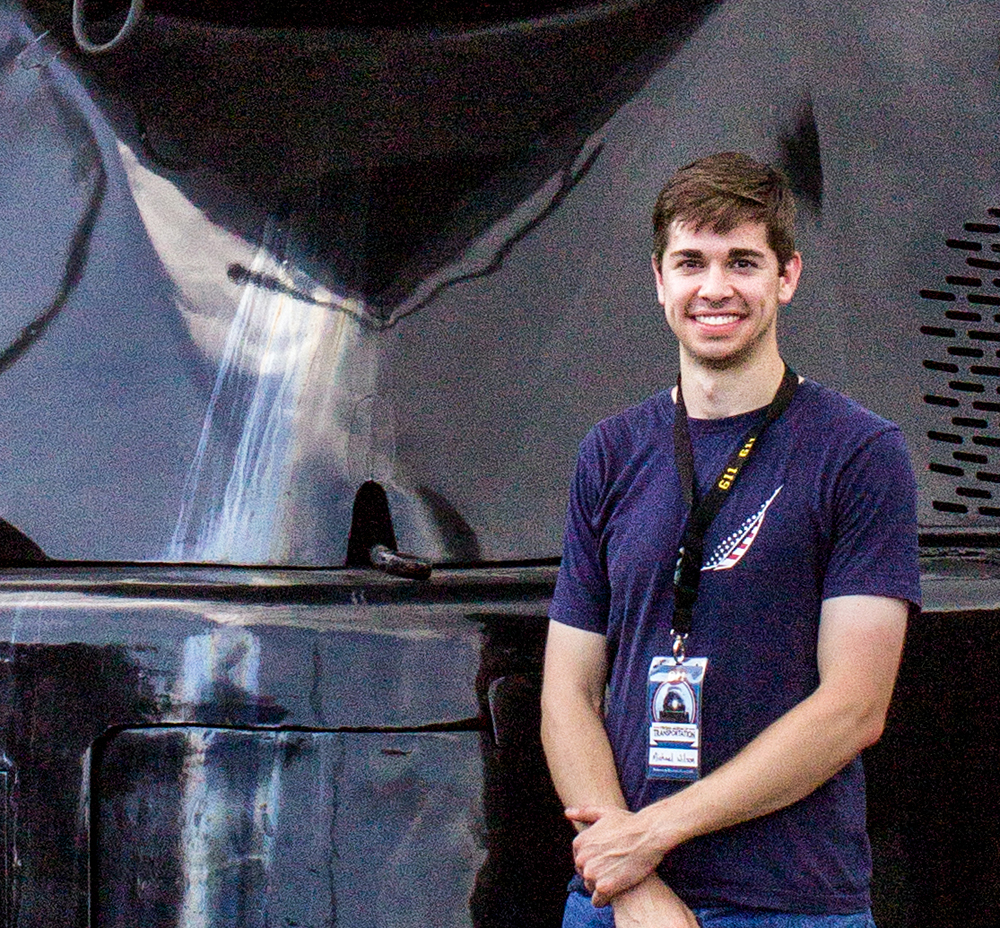




Thx for the additional background, Jerry. Much appreciated.
NWP became a fav of mine after visiting my son in Humboldt County a decade or so ago. Shadowing the entire line is pretty easy, and heartbreaking too, as most of the northern section up to Arcara Bay will likely never see a train again. (A politician has been lobbying heavily for a rail trail for years, and seems to have made progress) While the geography is challenging for a RR, it’s easy to visualize multiple trains a day running between Eureka and the Bay Area, back in the day….. The “Skunk Train” traverses a nice section of the former NWP. This old line is a gem for sure, worthy of a repeat visit.